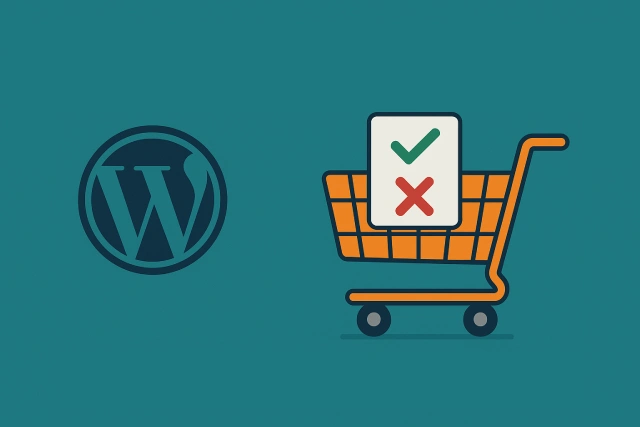وردپرس یکی از محبوبترین سیستمهای مدیریت محتوا در جهان است. بسیاری از وبسایتها، از جمله فروشگاههای آنلاین و پلتفرمهای تجارت الکترونیک، از این سیستم استفاده میکنند. با کمک افزونه ووکامرس، وردپرس به ابزاری قوی برای تجارت الکترونیک تبدیل میشود. با این حال، مانند هر پلتفرمی، مزایا و معایبی دارد. در این مقاله، مزایا و معایب استفاده از وردپرس برای فروشگاه اینترنتی شما را بررسی خواهم کرد.

فهرست مطالب
- مزایای استفاده از وردپرس برای فروشگاه اینترنتی
- معایب استفاده از وردپرس برای فروشگاه اینترنتی
- نتیجهگیری
مزایای استفاده از وردپرس برای فروشگاه اینترنتی
رایگان و مقرون به صرفه است
اول از همه، وردپرس رایگان است. شما فقط باید هزینه میزبانی وب، نام دامنه و قالبها یا افزونههای اختیاری را بپردازید. به همین دلیل، انتخاب بسیار خوبی برای مشاغل کوچک و استارتاپها است. میتوانید بدون متحمل شدن هزینههای قابل توجه، یک فروشگاه آنلاین جامع بسازید.
انعطافپذیری و کنترل را ارائه میدهد
وردپرس به شما این امکان را میدهد که ظاهر و عملکرد وبسایت خود را کنترل کنید. به عنوان مثال، میتوانید از بین هزاران قالب و افزونه، قالب مورد نظر خود را انتخاب کنید. در نتیجه، اضافه کردن ویژگیهایی مانند درگاههای پرداخت، فرمهای تماس و فیلترهای محصول آسان است. اگر کدنویسی بلد باشید، میتوانید تغییرات سفارشی نیز ایجاد کنید.
با ووکامرس به خوبی کار میکند
یکی دیگر از مزایای کلیدی، ووکامرس است. این افزونه رایگان، سایت وردپرس شما را به یک فروشگاه آنلاین کامل تبدیل میکند. این افزونه از محصولات فیزیکی و دیجیتال، مالیات، ارسال و گزینههای پرداخت پشتیبانی میکند. علاوه بر این، میتوانید افزونههایی را برای افزایش ویژگیهای فروشگاه خود در طول زمان نصب کنید.
جامعه پشتیبانی بزرگی دارد
علاوه بر این، وردپرس جامعهی عظیمی از کاربران و توسعهدهندگان دارد. میتوانید پاسخ سوالات خود را در انجمنها، وبلاگها و آموزشهای ویدیویی پیدا کنید. وقتی به کمک نیاز دارید، یافتن منابع رایگان آسان است. در صورت نیاز، میتوانید برای پشتیبانی بیشتر، متخصصانی را نیز استخدام کنید.
سئو فرندلی است
دیده شدن در موتورهای جستجو برای فروشگاههای آنلاین ضروری است. خوشبختانه، وردپرس با در نظر گرفتن سئو ساخته شده است. همچنین از افزونههایی مانند Yoast SEO یا All in One SEO پشتیبانی میکند. این ابزارها به بهبود محتوا، کلمات کلیدی و ساختار سایت شما کمک میکنند. در نتیجه، احتمال نمایش فروشگاه شما در نتایج جستجو بیشتر میشود.
معایب استفاده از وردپرس برای فروشگاه اینترنتی
به نگهداری منظم نیاز دارد
از طرف دیگر، سایتهای وردپرس به بهروزرسانیهای مکرر نیاز دارند. شما باید مرتباً سیستم اصلی، افزونهها و قالبها را بهروزرسانی کنید. اگر بهروزرسانیها را نادیده بگیرید، سایت شما ممکن است ناپایدار یا در برابر خطرات امنیتی آسیبپذیر شود. برای مبتدیان، مدیریت این امر میتواند دشوار باشد.
ممکن است مشکلات عملکردی داشته باشد
علاوه بر این، وردپرس فقط برای تجارت الکترونیک ساخته نشده است. با رشد فروشگاه شما، ممکن است وبسایت شما کندتر شود، به خصوص اگر تعداد زیادی محصول یا حجم بالایی از ترافیک داشته باشید. برای حل این مشکل، ممکن است به یک پلن میزبانی وب قویتر یا ابزارهای کشینگ (افزایش سرعت وبسایت) نیاز داشته باشید.
خطرات امنیتی دارد
از آنجا که وردپرس بسیار محبوب است، هدف هکرها نیز قرار میگیرد. افزونهها یا قالبهای ناامن میتوانند در را برای حملات باز کنند. بنابراین، شما باید از ابزارهای ایمن استفاده کنید، یک گواهی SSL نصب کنید و مرتباً از سایت خود نسخه پشتیبان تهیه کنید.
برای ویژگیها به افزونهها وابستگی دارد
برای افزودن ویژگیهای جدید، اغلب به افزونهها نیاز دارید. با این حال، استفاده از افزونههای زیاد میتواند مشکلاتی ایجاد کند. به عنوان مثال، برخی از افزونهها ممکن است با یکدیگر تداخل داشته باشند. برخی دیگر ممکن است پس از بهروزرسانیها از کار بیفتند. بنابراین، انتخاب افزونههای قابل اعتماد و بهروزرسانی مداوم آنها بسیار مهم است.
منحنی یادگیری دارد
اگرچه استفاده از وردپرس آسان است، اما راهاندازی یک فروشگاه میتواند زمانبر باشد. شما باید پرداختها، ارسال و تنظیمات مالیات را پیکربندی کنید. برای کسانی که تازه وارد تجارت الکترونیک شدهاند، این کار در ابتدا میتواند طاقتفرسا به نظر برسد. با گذشت زمان و پشتیبانی، آسانتر میشود.
نتیجهگیری
در پایان، وردپرس یک گزینه قدرتمند و مقرون به صرفه برای تجارت الکترونیک است. این سیستم کنترل کامل، ابزارهای سئو قوی و پشتیبانی از طریق ووکامرس را ارائه میدهد. این ویژگیها آن را برای مشاغل کوچک و متوسط ایدهآل میکند.
با این حال، با برخی چالشها نیز همراه است. شما باید آن را به طور منظم نگهداری کنید، افزونهها را با دقت مدیریت کنید و مطمئن شوید که سایت شما به راحتی کار میکند. مسائل امنیتی و یادگیری نیز میتوانند نگران کننده باشند.
با این حال، با راهاندازی و توجه مناسب، وردپرس میتواند بستری عالی برای ساخت و رشد فروشگاه آنلاین شما باشد. اگر مایل به یادگیری یا استخدام کمک هستید، این یک انتخاب انعطافپذیر و قابل اعتماد است.

دیدگاهتان را بنویسید